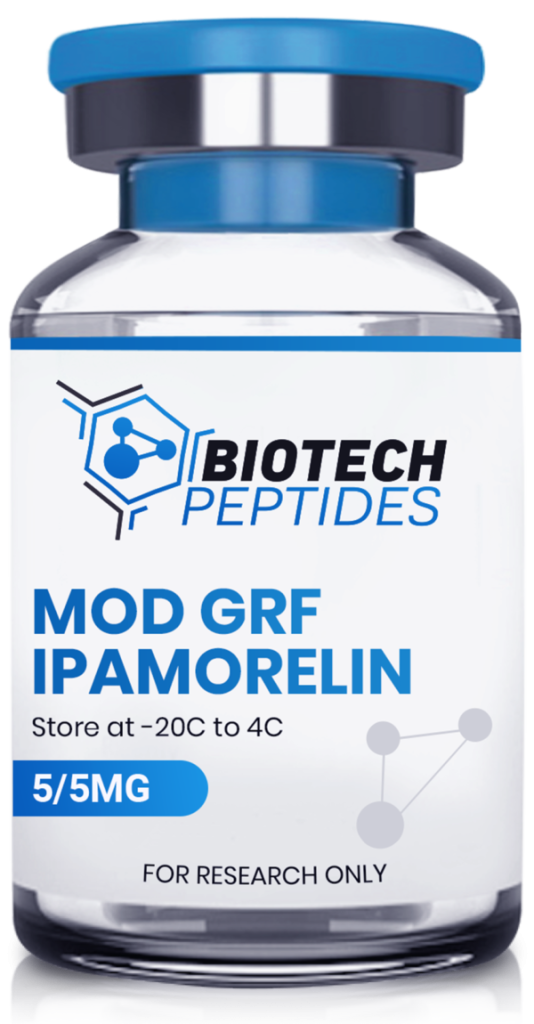GRF 1-29 Development:
Modified GRF (1-29), often known as Mod GRF, is a variation of the standard GRF (1-29). To stimulate the body’s own natural synthesis of growth hormone, Mod-GRF 1-29 is a synthetic form of GHRH (growth hormone-releasing hormone). When referred to as CJC-1295 without DAC (CJC-1295 W/o DAC), it is a chemical that stimulates the pituitary gland to produce more growth hormone, a growth hormone secretagogue. Mod-GRF contains four amino acid substitutions in its chemical structure, which is why it is known as “tetrasubstituted” GRF 1-29. In addition to boosting Mod GRF’s stability during storage, transit, and administration, these alterations also enhance its attraction for the GHRH receptor. Sermorelin and GRF 1-29, according to several experts, have a half-life that is regarded to be much more natural since they are thought to create a brief pulse of Human Growth Hormone.
The first mention of GRF (1-29) analogous peptide structures with tetrasubstituted GRF (1-29) was in a paper published in 2005. In GRF, the name was used to denote the substitution of amino acids 2, 8, 15, and 27 in the protein’s structure (1-29).
Modified GRF (1-29) was coined by DatBtrue in 2008. The nomenclature has been more widely known and accepted because of the widespread usage of the phrase on both public and private forums.
GHRH’s first 29 amino acids were shown to be just as effective as its 44-amino acid composition, according to a new study. GRF was the name given to this piece (1-29). For this reason, GRF (1-29) analogs were created to increase biological activity and limit the rate of metabolic clearance of GRF (1-29). Substituting amino acids that are more resistant to enzyme cleavage in the peptide structure led to the creation of these analogs. Early analogs replaced D-alanine for the optical isomer (perfect reflection) of L-alanine (acronymed as Ala or A) at the second place of the peptide sequence (abbreviated as D-Ala). An enzyme called dipeptidyl peptidase-4 has previously cleaved the peptide link between D-Ala and the 3rd amino acid in the sequence of aspartic acid (Asp) into an inactive fragment because of this substitution. Analogs with further amino acid changes were then created as a result of this successful alteration.
The Ipamorelin Peptide.
Ipamorelin, a powerful growth hormone (GH) secretagogue, has been developed, and pharmacology has been characterized. In vitro and in vivo, ipamorelin, a pentapeptide with high GH release potency and effectiveness (His-D-2-Nal-D-Phe-Lys-NH2), has been shown to be very effective. Ipamorelin was discovered in a series of compounds missing the core dipeptide Ala-Trp of growth hormone peptide (GHRP)-1. Ipamorelin, like GHRP-6, promotes GH release through a GHRP-like receptor, according to a pharmacological profile employing GHRP and GHRH antagonists. Ipamorelin produced GH with equal potency and effectiveness to GHRP-6 in pentobarbital anesthetized rats. Lower effectiveness, but more potency. In swine, the specificity of GH release was examined. FSH, LH, PRL, and TSH plasma levels were not altered by any of the GH secretagogues that were examined. Both GHRP-6 and GHRP-2 were shown to raise plasma levels of ACTH and cortisol, respectively, after their use. GHRH stimulation released ACTH and cortisol in amounts that were not substantially different from those elicited by ipamorelin. Even at dosages more than 200 times greater than the ED50 for GH release, ACTH and cortisol plasma levels remained unchanged. Finally, ipamorelin is the first GHRP receptor agonist with GH release selectivity comparable to GHRH. Ipamorelin’s specificity makes it a strong candidate for clinical trials in the future.
The peptides Mod GRF 1-29 and Ipamorelin combined
Find out how Ipamorelin and Mod GRF 1-29 (CJC 1295) work together to promote the natural synthesis of growth hormones for increased energy, fitness, and general health by learning about their advantages. For anti-aging and individuals with inflammatory disorders, illness, or low IGF-1 levels, the combination of Ipamorelin and CJC 1295 peptides is helpful. Together, the peptides CJC 1295 and Ipamorelin act as an amplifier and a GHRP for GHRH (or inducer). By boosting the power of the release of GH, as well as by expanding the number of cells that produce GH, this combination will aid in the growth of GH (somatotrophs). If you are a licensed professional interested in further investigating this blend, you can find Mod GRF (1-29) – Ipamorelin blend for sale online.

